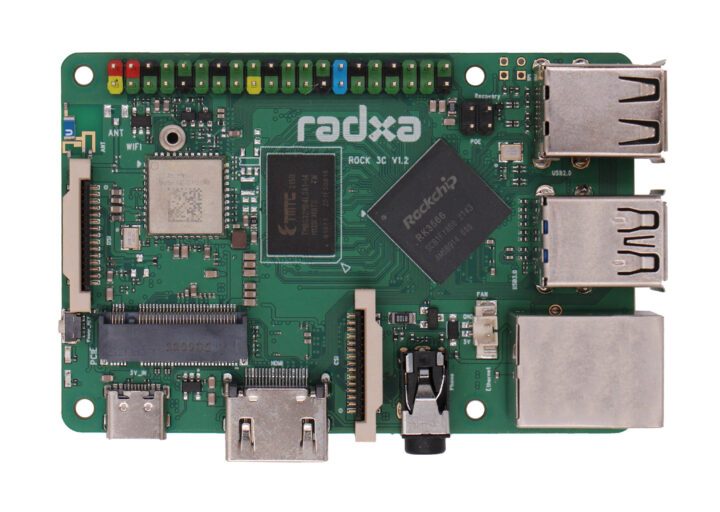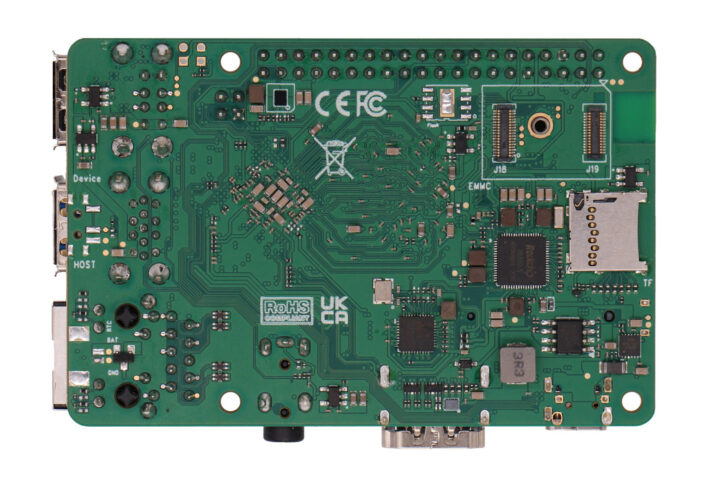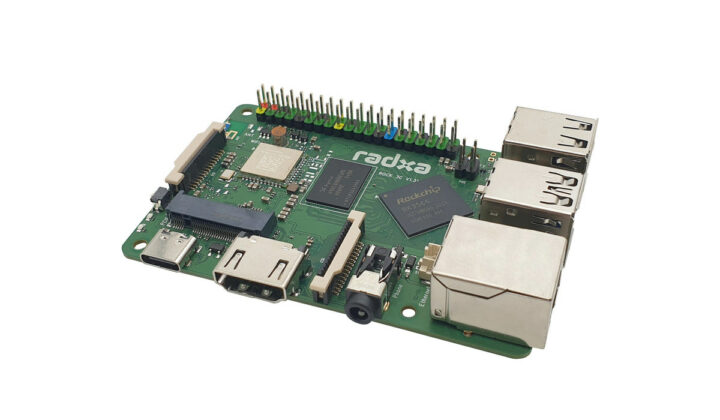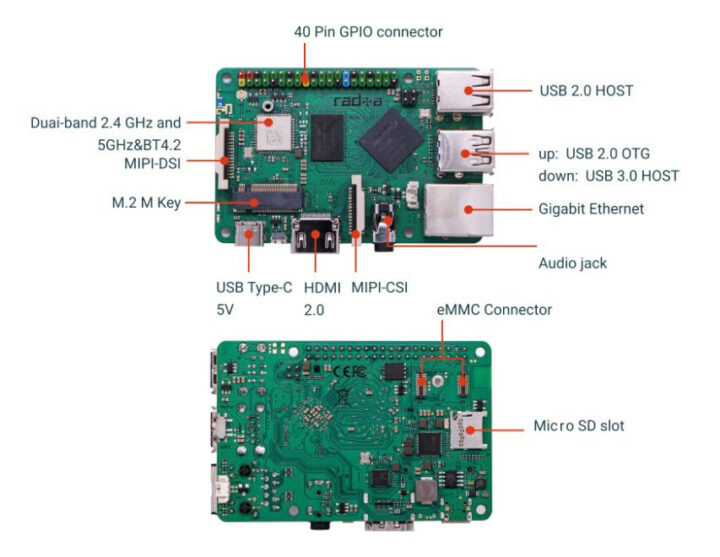Radxa ROCK 3C, also called ROCK 3 Model C, is a Rockchip RK3566-T Arm SBC with up to 8GB RAM and WiFi 5. It mostly follows the Raspberry Pi 3 Model B form factor, but also adds an M.2 PCIe socket for NVMe SSDs.
The single board computer also comes with a MicroSD card slot and eMMC flash module socket to boot the OS, a 4Kp60 capable HDMI 2.0 port, a MIPI DSI connector, a MIPI CSI camera connector, a 3.5mm jack with microphone, four USB ports, Gigabit Ethernet, and a 40-pin color-coded GPIO header.
ROCK 3C specifications:
- SoC – Rockchip RK3566-T quad-core Cortex-A55 processor @ 1.6 GHz with Arm Mali-G52 GPU, 0.8 TOPS NPU (AI accelerator)
- System Memory – 1GB, 2GB, 4GB, or 8GB LPDDR4 2112MT/s
- Storage
- MicroSD card slot
- eMMC module socket
- M.2 Key-M PCIe socket for 2230 NVMe SSD
- Video Output
- HDMI 2.0 up to 4Kp60
- 2-lane MIPI DSI connector
- Note: HDMI and MIPI DSI are multiplexed and cannot work at the same time.
- Audio – 3.5mm stereo audio jack with microphone support
- Camera I/F – 2-lane MIPI CSI input for up to 8MP cameras
- Networking
- Gigabit Ethernet RJ45 port with optional PoE support
- Dual 2.4GHz/5GHz WiFi 5 (802.11 a/b/g/n/ac) and Bluetooth 5.0
- USB –
- USB 2.0 OTG port (middle upper one) with hardware switch for host/device switch
- 1x USB 3.0 host port
- 2x USB 2.0 host ports
- Expansion
- 40-pin Raspberry Pi-compatible header with 2x I2C (up to 400 kbps), 1x SPI, 5x UART, 6x PWM, 1x ADC, 6x GPIO, 5V, 3.3V, and GND
- 1x M.2 PCIe socket for SSD
- Misc – Recovery button, 2x LEDs, RTC connector
- Power Supply
- 5V/3A via USB-C port, 5V/5A recommended when an SSD is connected
- PoE connector
- Dimensions – 85 x 56 mm (Raspberry Pi 3 Model B form factor)

 Radxa provides official images for Debian 11 and Ubuntu 20.04 Server, but Android 11 is not offered (yet). More technical details and instructions to get started can be found in the wiki.
Radxa provides official images for Debian 11 and Ubuntu 20.04 Server, but Android 11 is not offered (yet). More technical details and instructions to get started can be found in the wiki.
As one may have guessed, the ROCK 3C board is the third ROCK 3 SBC from Radxa, with the ROCK 3A having similar specifications and form factor but with a Rockchip RK3568 processor that enables dual display support and adding an M.2 Key-E for up to WiFi 6 wireless modules, and the upcoming ROCK 3B Pico-ITX SBC.
The Radxa ROCK 3C was optimized for cost, and the 1GB RAM model sells for $39 and the 2GB variant for $44 plus shipping, taxes, etc… The 4GB and 8GB RAM models are listed for $54 and $74 but are currently out of stock. The board is also showcased on the OKDO and Rockchip booths are the Embedded World 2023 conference.
Via LinuxGizmos.

Jean-Luc started CNX Software in 2010 as a part-time endeavor, before quitting his job as a software engineering manager, and starting to write daily news, and reviews full time later in 2011.
Support CNX Software! Donate via cryptocurrencies, become a Patron on Patreon, or purchase goods on Amazon or Aliexpress. We also use affiliate links in articles to earn commissions if you make a purchase after clicking on those links.







> RK3566 quad-core Cortex-A55 processor @ 1.6 GHz
Are these 1.6 GHz overtaken from Radxa? Since RK3566 was marketed as 1.8 GHz capable and ‘in the wild’ we’ve seen clockspeeds between 1680 and 1910 MHz (caused by PVTM).
When I first copy/pasted the specs from another RK3566 board, it was 1.8 GHz, but then I noticed Radxa only shows it clocked up to 1.6 GHz, so I went with that. Maybe they are using some cheaper RK3566 that can only do up to 1.6 GHz for this board?
Or maybe they just remove the 1800 MHz OPP from the board’s DT prior to building OS images?
Then consumers are not confused by these mismatches between ‘advertised’ and real clockspeeds, believe they would run a 1.6 GHz CPU and if they’re lucky (‘better’ silicon variant at low ambient temperature) the thing clocks 300 MHz higher, a difference nobody would notice anyway with any standard use case 🙂
Radxa is using standard RK3566/RK3568 DVFS/DT settings as such it’s just ‘product marketing’ keeping the expectations low so no consumer starts crying later having to run a ‘1.8 GHz CPU’ ~100 MHz lower in reality.
BTW: Once Radxa produces a key M breakout board like this you could also mention the native SATA capabilities of the M.2 slot.
There will be a breakout board, and we will test if B+M key SATA SSD can be used natively.
ROCK 3C uses RK3566-T SoC, so the max clock is lower. Just like RK3399-T used on ROCK 4SE and 4C+.
The attached picture uses regular RK3566. On v1.3 hardware I have it is RK3566-T already. It has an extra white dot after the RK3566 text on the chip.
Not the two versions of the one chip again, last time in media boxes that caused many failed expectations, wonderful Rockchip.
yeah i prefer if they just rename it like the rk3328/3318, so we know which is which
Well, it’s not as bad as amlogic calling everything “S905″…
Y3 Y2 X5 LMNOP43? Please, Amlogic, stop!
I have got one 3c board with system from Radxa and it runs at 1800Mhz.
Can you share output from this directly after a reboot?
dmesg | grep -E “rockchip-cpuinfo|pvtm”
dmesg | grep -E “rockchip-cpuinfo|pvtm”
[ 0.148371] rockchip-cpuinfo cpuinfo: SoC : 35662000
[ 0.148383] rockchip-cpuinfo cpuinfo: Serial : 1756de764791775f
[ 1.060733] cpu cpu0: pvtm = 85470, from nvmem
[ 1.060751] cpu cpu0: pvtm-volt-sel=1
[ 1.105003] mpp_rkvenc fdf40000.rkvenc: pvtm = 85470, from nvmem
[ 1.105012] mpp_rkvenc fdf40000.rkvenc: pvtm-volt-sel=1
[ 4.606787] mali fde60000.gpu: pvtm = 85470, from nvmem
They should put the SoC in the bottom, so it’s easier to cool down.
There’s not much to cool with RK3566/RK3568. The supply voltages for the A55 cores at 1.8 GHz are just 1050 mV while for example Raspberries that need good cooling like e.g. the RPi 3B / 3B Plus fry their A53 with ~1350mV already at 1200 MHz (3B) or at 1400 MHz (3B+).
Asides that this thing has obviously been designed as a direct HW replacement for those aforementioned Raspberries as such heat dissipation over the PCB bottom would be somewhat counterproductive 🙂
Thanks for the info. Didn’t know that RPi use >= 1350mV for their board.
Please let us get away from this horrible form factor. It’s just painful to see boards mangled to fit it.
Don’t you think they use ‘this horrible form factor’ by intention simply since it’s there and widely adopted, since products are built around this and Radxa seeing the opportunity to cash in on this by providing a 1:1 HW replacement?
Unlike those Raspberries that should be replaced with this 3C you’ll have a hard time ‘overheating’ RK3566 and the M.2 slot provides reliable storage options (NVMe or SATA) internally.
If the idea is compatability, then they have to put the ports in the same places and make them the same size. There’s no Rpi with this port layout, so they’re already making a unique footprint. Is it sufficient to have the GPIO in the same location and *roughly* compatable? Unless they get all the alternate functions, etc. the same, you know that plenty of shields will be incompatable. Not to mention the shields often rely on software *warts* of raspbian (or whatever they’re calling it today).
> they have to put the ports in the same places and make them the same size
Which is what they did:
https://i.ibb.co/gjsV35y/Bildschirmfoto-2023-03-17-um-12-18-50-klein.png
Fortunately Radxa exchanged the power connector and upgraded crappy Micro USB to USB-C in exact same position which could result in problems with some metal RPi enclosures. But other than that this thing looks to be designed to be a 1:1 RPi 3B/3B+ replacement.
For some reason I had the 4B in mind when I said that. You’re quite right, that’s just a little light filing work away from a 3B. Thanks for the correction.
Agreed, ports on one, max two sides.
Agreed. Hopefully opposing sides at that. At least it’s an improvement over the first Pi with crap on all four sides (and the top).
Normalize bottom mounted CPUs/memory that fit board sized heatsinks which double as a case part.
As mentioned the eco system seems to have grown up, around these shapes and designs which makes cases and coolers easier to modify or source, maybe, that is why so many copy the design..
After all The Tart, has left a market hungry for products that the Tart manufacture cannot supply enough of their boards too.
As for heating who knows the reason, maybe the initial design, had a heat spreading to components issue or something ?
No uFL connector as advertised and I’m unable to get WiFi to work, on mine.
There’s a ceramic antenna on the board. You should inform them about the WiFi issue on Radxa forums, maybe they’ll have a solution, or if there’s a hardware issue then you can return the board.